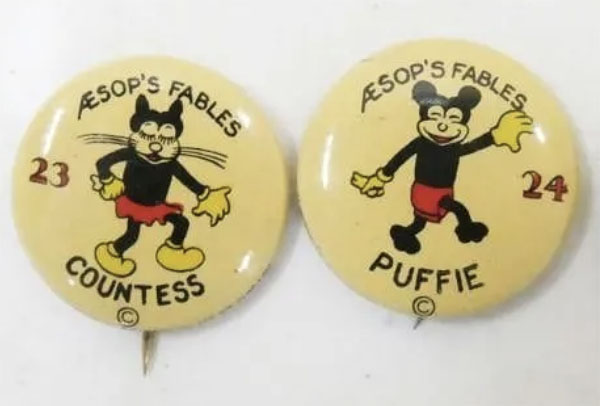
The “Countess” and “Puffie” may (or may not) appear in any of the films detailed below – but they were certainly a presence in Van Beuren cartoons during 1931. They represent the era – so we are happy to showcase them here.
1931 was a busy year for Gene Rodemich. Not only was he doing the scoring for all the Van Beuren cartoons, but he also had to do the same for a series of live-action films Van Bueren was also distributing – the Mutual comedies of Charlie Chaplin. These shorts had of course been produced silent back in 1916-1917. Rodemich had to produce both scores and sound-effects tracks. Most of these use a fairly large orchestra, probably including most of the well-known musicians’ union suspects who were also regularly heard on contemporary record dates of the period – including Benny Goodman on clarinet. One short, however (One A.M.) features a spunky little combo. For the cartoons, increasing use of a male quartet is present, although I am unable to identify any of the singers involved. There is no sign that they had been moonlighting at Max Fleischer’s.
The Fly Guy (5/10/31) – During this time, referring to someone as a “Fly Guy” meant that he was hep to the jive. Of course, Van Beuren takes the expression much more literally. Not a sheet of flypaper to be found, however, as our hero and heroine visit a fly night club inside a glass jug. Another spider, another fight. Songs: “A Bird In a Gilded Cage”, published in 1900, recorded at the time by Steve Porter on Columbia cylinder, and Harry Anthony on Edison cylinder. Arthur Fields would dredge up the number for Grey Gull. By the 1930’s it was common to perform the tune in an over-exaggerated, melodramatic manner evoking the Gay 90’s. Florie Forde, a British music hall star, performed it in such manner for British Imperial in 1932. Jerry Colonna would give it plenty of schmaltz for Vocalion (below). Virginia O’ Brien would give it her personal treatment on Decca. In later years, it was revived by Beatrice Kay for Columbia. Bing Crosby would include it on a sing-along album. The song would even find its place into the Disneyland attraction, “America Sings”. Also, an original song, “I’m Sentimental Over You”, not to be confused with any number associated with the Dorsey Brothers. And a reappearance for “The Whistler and His Dog”.
Fisherman’s Luck (6/13/31) – Various gags about a dog fishing (including the usual fish eats fish eats fish pile on the line, only to all fall off one by one). The dog cavorts under the sea with a cat mermaid, then she follows him home for a romantic ending on land. Songs: “I’m Happy When You’re Happy”, a 1931 pop tune, performed on record by Benny Goodman on Melotone, the Radiolites with Scrappy Lambert on Columbia, Tom Gerun’s Orchestra on Brunswick, Jack Leon and his Orchestra on British Simcha, and Harry Hudson’s Deauville Band with Sam Browne on British Edison Bell.
Fun On The Ice (7/19/31) – Lots more winter gags, based on bobsledding, skating, ice hockey, etc. A fat female hippo crashes through the ice into the water, and a St Bernard with a brandy barrel pours his supply into her baboon boyfriend instead, The intoxicated baboon can’t aim himself to dive into the ice hole, as the thing seems to move wherever he isn’t, so he forgeys about saving the lady, and merely hands her a sign to hold reading “Danger”. Songs: “Jingle Bells”, “Winter”, and “Over the River and Through the Woods” the latter of which Danny Kaye and the Andrews Sisters performed for Decca, under the title “A Merry Christmas at Grandmother’s House”.
Wot a Night (8/1/31) – The names Tom & Jerry together, go back to the 1820’s – which may be the beginnings of the famous cocktail, involving the preparation of a special batter and two or three types of booze. The drink is popular in the South, though seen in most other parts of the country as more old-fashioned than the “Old Fashioned”. Tom and Jerry run a ramshackle taxi business on a dark and stormy night. A couple of tall bearded gentlemen take their taxi to a mysterious castle on a hill. Weirdness ensues. A skeleton tries to adjust a piano stool to sit down comfortably, but it’s not an easy task, so he unscrews his hip bone to adjust for height. A black skeleton quartet performs a Negro spiritual. Tom and Jerry wind up from their visit emaciated to skeletons themselves. Songs: “I’ll Be Ready When the Great Day Comes” – It would receive a recording by the Forbes Randolph Kentucky Jubilee Choir on Brunswick in the late 1920’s, the Cotton Belt Quartet on Vocalion, and the Spirits of Rhythm on Brunswick in the early 1930’s.
Love In a Pond (8/17/31) – Romance in a frog pond, leading to a wedding, Not much in the way of plot. Songs: “Gilly Gallah Galloo” – I have no idea if this is an original or something from Vaudeville – no known recordings. Also a return for the “Wedding March”
Fly Hi (8/31/31) – More love among flies, with not a sign of Flit or flypaper/ Does not progress to the stage of a wedding. There is a villain – a spider who invites the couple into his parlor, after which his intentions become crystal clear. Songs: “All Alone”, a tender waltz written by Irving Berlin in 1924. It was recorded by John McCormack on red seal Victrola, Miss Lee Morse for Perfect and Pathe, Al Jolson for Brunswick, Lewis James for both Victor and Columbia, Walter Scanlon on Edison Diamond Disc, and Marie Dawson Morrell on Vocalion, For dancing, Paul Whiteman on Victor, the Statler Hotel Dance Orchestra on Lincoln, and Harry Raderman on Edison, Revivals included Sammy Williams and the Three Naturals on Vocalion, Savannah Churchill on Manor, and Ken Griffin on Columbia. A second song, “I ‘Wanna’ Sing About You”, was recorded by Bert Lown and his Hotel Biltmore Orchestra for Victor, Paul Tremaine on Columbia, Hal Kemp on Brunswick, Owen Fallon and his Orchestra on Melotone, Dick Cherwin on Perfect, Banner, et al., Bert Hirsch and the Hit of the Week Orchestra on Hit of the Week cardboard record, and a vocal version by Roy Evans on Crown. “I’m Keepin’ Company”, also featured, was recorded by Rudy Vallee on Victor, a Ben Selvin studio group for Harmony, Velvet Tone, and Clarion (featuring a good deal of Benny Goodman on clarinet), and Frank Novak on Crown. British versions included Billy Cotton on Columbia, and Sid Phillips on Edison Bell Radio.
The Family Shoe (9/14/31) – A mashup of plot elements from The Old Woman Who Lived in the Shoe and Jack and the Beanstalk. Jack recovers the golden goose, who itself plays the harp while laying golden eggs. The old lady’s shoe gets a fancy makeover. Songs: “The Woman in the Shoe”, from the 1929 MGM feature, “Lord Byron of Broadway”, written by Arthur Freed and Maceo Herb Brown. Nat Shilkret and the Victor Orchestra performed a dance record for Victor. The Revelers also issued a vocal rendition on the same label. Ben Selvin covered with a dance version on Columbia, Jesse Stafford’s Orchestra followed suit for Brunswick. The Revelers would repeat a chorus of the tune for the 33 1/3 rpm “Victor Artists’ Party” demonstration disc used to promote the Program Transcription player. Also in the film is “Sleep, Baby, Sleep”, a 19th century song. The best-known version of this was Jimmie Rodgers’ first record on Victor. There is also a short original number included in the film for the giant: “I am the Owner of the Golden Goose.”
Trouble (10/10/31) – Tom and Jerry are lawyers, specializing in accident injury cases. They should be in top physical form, considering the ambulances they have to chase, but they haven’t had a case in a month. (All this, and the depression was getting deeper.) They converge, presumably together with all the other attorneys in town, upon the site of a spectacular accident involving a human fly, a tall skyscraper, and a dirigible, only to find that the victim who has plunged 100 stories is doing the whole thing as a publicity stunt, handing out business cards as “Joe Spoof, world-famous slow motion actor.” Songs: “Accident”, apparently a original, sung in duet by our heroes.
More 1931, and into ‘32, next time.


 James Parten has overcome a congenital visual disability to be acknowledged as an expert on the early history of recorded sound. He has a Broadcasting Certificate (Radio Option) from Los Angeles Valley College, class of 1999. He has also been a fan of animated cartoons since childhood.
James Parten has overcome a congenital visual disability to be acknowledged as an expert on the early history of recorded sound. He has a Broadcasting Certificate (Radio Option) from Los Angeles Valley College, class of 1999. He has also been a fan of animated cartoons since childhood.











































In addition to the pins, Countess and Puffie were part of a line of Aesop’s Fables dolls manufactured by the W. R. Woodard Co. of Los Angeles in 1929-30. I think Puffie is supposed to be a bear.
I believe the Gilly-ga-whatever song sung by the frogs in “Love in a Pond” was written specifically for the cartoon. After all, the lyrics refer to frogs, sitting on logs, and so on. However, I did recognise another tune in “Love in a Pond”: the old American folk song “The Crawdad Hole”. Andy Griffith sang it in an episode of his eponymous sitcom.
I dug up the sheet music to “I ‘Wanna’ Sing About You”, and yes, the word “wanna” is in quotes every time it occurs (and it occurs a lot). Strange that they did that, as “wanna” wasn’t exactly a jazz age neologism; Stephen Crane used it in his first novel “Maggie: A Girl of the Streets” back in the 1890s. A decade earlier, Joel Chandler Harris was contracting “want to” into “wanter”. (That’s what Uncle Remus said!)
You really have to hand it to Gene Rodemich. His musical arrangements were a lot more sophisticated, and better executed, than anything Bert Lewis was doing at Disney at this time.
I want those Van Beuren toys now!
“Gilla, Galah, Galoo” was recorded by the Avon Comedy Four for Victor, Camden NJ, July 31, 1916. Take 2 was issued on Victor 18125. I have the record and here’s a link to detailed info and a downloadable audio file at DAHR:
https://adp.library.ucsb.edu/index.php/matrix/detail/700003209/B-18166-Gila_galah_galoo
I don’t intend this as a reprimand, but James, you really ought to take advantage of this resource rather than rely on YouTube.
Thanks for that link, Rich. I went searching for the song myself, but while I tried several alternative spellings of the nonsense words in the title, I didn’t hit upon the right one. I only wish I had known it fifteen to twenty years ago, when I used to keep frogs — it would have been fun to sing while changing the water in the tadpole tank!